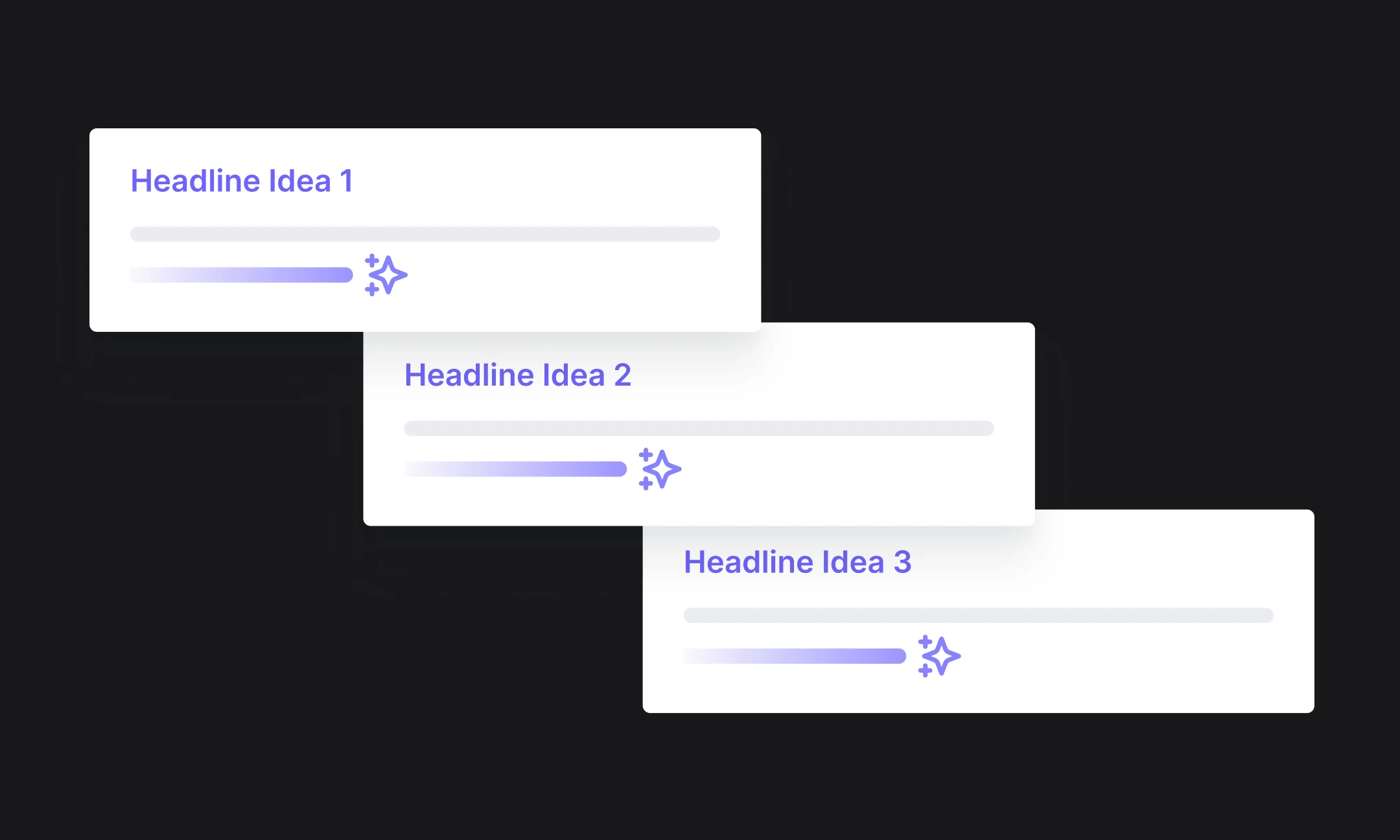Generate compelling headlines instantly.
Describe your topic and keyword

Select your favourite title

Brainstorm more headlines

Titoli accattivanti a portata di mano
Titoli interessanti scritti dal nostro generatore di titoli di articoli AI
First impressions last. Great titles are clear, succinct, and straightforward. They evoke the interest of the reader, set the tone for the rest of the article, and tell the reader what they can expect from the article without over-promising or under-delivering.
If you need some inspiration, here are some of examples of strong titles that our headline generator tool has produced that are sure to capture the attention of your target audience.








Domande frequenti
What is a headline generator?
A headline generator is a type of software that helps you create headlines for your articles or blog posts. It can be a great tool to help you come up with new and interesting headlines, especially if you're struggling to come up with something that's catchy and attention-grabbing. Previous versions of headline generators used templates, which would provide you with a selection of pre-determined headlines to choose from. However, the best use of headline generators now is through the use of AI, which can create custom headlines for you based on the content of your article.
What's considered a catchy headline?
There's no one-size-fits-all answer to this question, as the definition of a catchy headline can vary depending on who you ask. However, a good rule of thumb is to think about how you can hook your readers and pique their interest from the get-go. One way to create a catchy headline is to be creative and try to come up with a original angle. You can also make use of puns, alliteration, or rhyming words to make your headline stand out. Additionally, it's important to make sure your headline is clear and concise, and that it accurately reflects the content of your article. Ultimately, it's up to you to decide what makes a good headline, but keeping the above tips in mind should help you create something that readers will want to click on.
How do you write a headline?
There's no one-size-fits-all answer to this question, as the best way to write a headline depends on the specific content and target audience of your article. However, there are a few general tips to keep in mind when writing headlines: 1. Make sure your headline is catchy and interesting. Your headline should capture the reader's attention and make them want to learn more about your article. Try to avoid boring or generic headlines, and think outside the box to come up with something unique and eye-catching. 2. Make sure your headline is relevant to your content. Your headline should accurately reflect the topic of your article. If readers click on your article expecting one thing, but they find something completely different when they start reading, they're going to be disappointed � and might not come back for future articles. 3. Make sure your headline is easy to understand. Your headline should be clear and concise, giving readers a brief overview of what the article is about without being too wordy or confusing. Try to use simple, everyday language that most people will be able to understand.
Is a title the same as a headline?
There is definitely some overlap between titles and headlines, but they're not exactly the same. Titles are typically used when talking about a book, article, or other piece of writing, while headlines are used when talking about news stories or blog posts. That said, the line between them can be blurry. For example, a headline might also be the title of an article, or a title might be used as the headline for a blog post. And sometimes newspapers will use a headline for an article on the front page, and then use the title of the article for the byline on the inside pages. Overall, though, titles and headlines generally have different purposes. Titles are meant to give readers a sense of what the piece is about, while headlines are meant to grab people's attention and make them want to read more.
Is Hypotenuse AI's headline generator free?
Yes, Hypotenuse AI's headline generator is free to use during our 7-day free trial. You can generate an unlimited number of headlines using the tool, and there are no restrictions on how you can use them. However, if you want to generate more than the words given to you for the trial, you'll need to purchase a plan.
I vantaggi di una grande headline
Perché i titoli degli articoli sono importanti?
Proprio come spesso giudichiamo i libri dalla copertina, giudichiamo i siti web/gli articoli dai titoli e dalle prime pagine.
In effetti, il vostro titolo potrebbe essere l'unica ragione per cui il vostro sito web non raggiunge il suo massimo potenziale. Basta apportare alcune modifiche al titolo per aumentare il traffico verso il vostro sito fino al 500%.
Quando si crea un sito web, si vuole che più persone lo visitino e interagiscano con i contenuti. Più il pubblico è coinvolto e numeroso, più è probabile che il sito cresca e prosperi.
I titoli occupano un posto esclusivo nel contenuto che presentate a un lettore e i lettori spesso decidono se cliccare o meno sul link o rimanere solo dopo aver letto il titolo.
Ciò significa che il titolo potrebbe essere l'unica possibilità di fare una prima impressione duratura, quindi è importante che sia forte. Scrivete un titolo che mostri la versione migliore del vostro articolo e che catturi l'attenzione del lettore.
Cosa rende un titolo buono e accattivante?
Riteniamo che un titolo forte debba essere semplice, informativo e diretto. Ciò significa condensare efficacemente il succo dell'articolo per far capire al pubblico di riferimento cosa aspettarsi e se vale la pena leggerlo o meno.
I titoli migliori sono accattivanti e avvincenti, ma non spammosi e clickbaity. Stabiliscono il tono giusto per l'articolo e utilizzano una selezione di parole molto deliberata e precisa. Ad esempio, un titolo più informale, con parole informali, crea un precedente per un articolo più colloquiale o divertente, mentre un titolo più serio apre la strada a un articolo più accademico e scientifico.
Ecco alcuni esempi di titoli efficaci:
1. "Come usare un generatore di titoli per scrivere titoli migliori".
2. "3 semplici consigli per scrivere titoli efficaci".
3. "Come rendere i vostri titoli più adatti alla SEO".
4. "5 modi per rendere i vostri titoli più coinvolgenti".
Cosa si può fare per rendere un titolo più convincente?
Quanto traffico state perdendo a causa del vostro titolo? È emerso che l'80% delle persone leggerà il titolo, ma solo il 20% farà effettivamente clic, il che significa che il titolo è fondamentale per la visualizzazione e il traffico di un articolo.
Se volete imparare a scrivere titoli d'impatto che favoriscano il coinvolgimento, continuate a leggere. Condivideremo i consigli su come scrivere titoli forti.
- Siate specifici e pertinenti: Assicuratevi che il titolo sia specifico per l'articolo che state scrivendo e che rappresenti accuratamente il contenuto.
- Usare parole chiave esatte: L'uso di parole chiave nel titolo può ancorare l'argomento nella mente del lettore e migliorare il posizionamento SEO segnalando la rilevanza al motore di ricerca.
- Mantenere la brevità: i titoli dovrebbero essere di circa 6-8 parole per ottenere i migliori risultati (e per evitare di essere tagliati fuori nei risultati di ricerca).
- Use numbers and statistics: Numerals against a line of text stand out, making your headline more eye-catching. Instead of writing a headline with the words “five ways”, write a headline with the words “5 ways”.
People naturally gravitate towards specific statistics, which also make you sound more credible and trustworthy.
- Creare un senso di urgenza: Se possibile, cercate di creare un senso di urgenza o di eccitazione nella vostra headline per incoraggiare i lettori a cliccare.
- Brainstorm, brainstorm, brainstorm!: To make sure your article ranks well and your headline is clickable, maximize your chances by brainstorming a variety.
Try writing a dozen or more headlines before choosing the best. If you’re having trouble coming up with that many headlines, maybe our headline generator can help.
Quanto deve essere lungo un titolo?
I titoli devono essere abbastanza lunghi da comunicare efficacemente il succo dell'articolo, ma sufficientemente brevi da non essere tagliati nella SERP e da non essere troppo impegnativi. La lunghezza ideale? Le ricerche dimostrano che si aggira intorno ai 60 caratteri.




















